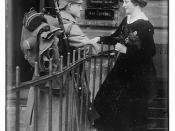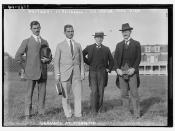Microscopes were invented in the 1600s. Robert Hooke first looked at a thin slice of cork in 1665; he saw "a lot of little boxes." These little boxes first reminded of the little rooms monks lived in, so he called them cells. Hooke observed the same pattern in the stems and roots of carrots and other plants. What Hooke still did not know, however, was that cells are the basic units of living things.
Ten years later, the Dutch scientist Anton van Leeuwenhoek focused a microscope on what seemed to be clear pond water and discovered a wondrous world of living creatures. He named the tiny animals "animalcules."
It took scientists more than 150 yrs. to fully appreciate the discoveries of Hooke and Leeuwenhoek. In 1838, the German botanist Matthias Schleiden concluded that cells compose not only the stems and roots but every part of a plant. A year later, the German zoologist Theodor Shwann made the same claim about animals.
And in 1858, a German physician Rudolph Virchow observed that cells come only from other cells. The observations of Shleiden, Shwann, and Virchow form what is known today as the cell theory. The cell theory is stated in three parts:
1.All living things are composed of one or more cells.
2.In organisms, cells are the basic units of structure and function.
3.Cells are produced only from existing cells.
All cells, even those that are very simple, all share certain characteristics. All cells have a cell membrane or plasma membrane, which separates the cell's contents from materials outside the cell. The cell membrane also determines what goes in and out of the cell, helping to maintain homeostasis. Without the cell membrane, the cell would die, because it would loose the substances it needs to maintain life.
All cells have a cytoplasm, which is everything inside the cell membrane except the cell's genetic material. The fluid portion of cytoplasm is called cytosol.
The cytosol is packed full of free-floating ribosomes, the structures on which proteins are made.
The prokaryotic cells lived at least 3.5 billion yrs. ago, the oldest fossils we have of cells. Prokaryotes are single-celled organisms that lack internal membrane-bound compartments.
The first cells with internal compartments were Eukaryotes. These cells evolved about 1.5 billion yrs. ago. Much larger than any bacteria, these cells ranged from 2 to 1000 (upside down h)m in size. The term eukaryotic comes from the Greek words eu, meaning "true," and karyote, meaning "kernel" or "nucleus." Eukaryotes have a nucleus, a membrane-bound compartment that houses the cell's DNA. They also possess other small, specific membrane-bound internal compartments called organelles that carry out specific functions.
Early eukaryotes were single-celled, but eventually many of them became aggregated (clustered) into multicellular organisms. Multicellular organisms are those that are composed of more than one cell. Being multicellular was a great evolutionary advance because it enabled particular cells to specialize in certain activities.
Not all eukaryotes are multicellular. You would find that most living eukaryotes are unicellular protists, single-celled organisms.
Why can't cells be large? One limit is related to the exchange of materials between the inside and outside of the cell, and the other limit is related to the distribution of materials within the cell.
A cell's surface provides the only opportunity for interaction with its environment. All information and materials entering or leaving the cell, includes wastes, must pass through "doors" in the cell membrane. The efficiency of such an exchange depends on the ration of the cell's surface are to its volume. Large cells have far less membrane surface per unit of volume with which to supply materials to the cell's interior and to rid it of wastes.
A second limit governing the size of cells has to do with transport within the cell itself. As cell size increases, it takes longer for information and materials to reach their destination. Small cells, therefore, function me efficiently than larger cells.
All living and nonliving things are composed of atoms. Every atom consists of a cloud of tiny particles called electrons that spin in undefined paths around a small, very dense core called a nucleus.
The nucleus is a cluster of two kinds of particles, protons and neutrons. To understand atoms you must remember that electrons carry a negative charge and protons a positive charge, neutrons are not charged. It is the attraction between positive and negative charges that keeps the electrons spinning about the nucleus.
An element is a substance that cannot be broken down to any other substance by ordinary chemical means. There are currently more than 100 known elements. Each is denoted with a one, two, or three-letter symbol. For example, carbon is represented by C, oxygen by O, and hydrogen by H.
Atoms as a whole have no electrical charge. Some atoms can react with other atoms to form particles with unequal numbers of electrons and protons. These kinds of atoms are called ions.
A compound is a group of atoms held together by chemical bonds. Compounds are represented by chemical formulas like NaCl (sodium chloride, or table salt) and H2O (water).
Covalent bonds form when two atoms share electrons. A group of atoms held together by covalent bonds is called a molecule.
Stable atoms have filled outer energy levels. All atoms in living things (except hydrogen and helium) have outer levels that hold eight electrons.
Ionic bonds form between two atoms of opposite charge. The force of attraction between a positive and negative ion is an ionic bond. Substances that form ionic bonds break apart when placed in water, producing free ions.
Water molecules act like a molecular magnet, with positive and negative ends, or "poles." Molecules that have unewual areas of charge, like water, are polar molecules. A hydrogen bond is a weak chemical bond that forms between two polar molecules.
Water is a major component of cells. Water stores heat. Water clings to itself and other molecules. Water Ionizes. Water is a powerful solvent.
Any compound that forms hydrogen ions when dissolved in water is called an acid. When an acid is added to water the hydrogen ion concentration is increased.
Any substance that ionizes to form hydroxide ions when dissolved in water is called a base. Bases lower the hydrogen ion concentration of water because hydroxide ions react with hydrogen ions to form water molecules.
Carbohydrates are composed of carbon, hydrogen, and oxygen atoms in the proportion 1:2:1.
Polysaccharides are carbohydrates that are made by linking individual sugars together to form long chains. Organisms store the energy contained in sugars like glucose by converting glucose into an insoluble form for future use. Starch a common storage form of glucose, is composed of long chains made of hundreds of glucose molecules. When your body digests starch, the long starch chains are broken into short fragments. Your body then stores the glucose-containing fragments in longer chains called glycogen.
Many organisms use polysaccharides as structural material. In plants, for example, glucose molecules are joined together in long chains forming cellulose. Cellulose, a major component of the cell wall of plants, provides structural support for plants. Cellulose and glycogen have different structural formulas. Your body is not able to break the links joining the glucose subunits in cellulose chains, so you cannot obtain energy from eating grass.
Lipids store energy and are a component of cell membranes.
Saturated fats are called saturated because they contain the maximum number of C - H bonds possible. Unsaturated fats have carbon-carbon double bonds at various points along the fatty acid chain. They are called unsaturated because fewer hydrogen atoms can bond to the carbon chain when there are double bonds between carbon atoms.
Animal cell membranes also contain cholesterol, which is yet another kind of lipid called a steroid. Many of the hormones that your body uses to control its activities are steroids. There are many other kinds of lipids, including important pigments, light-absorbing substances such as the chlorophyll of green plants, and the pigment retinal found in your eyes.
Proteins are the third major group of macromolecules. The most abundant protein in your body is collagen, a fibrous protein that forms the matrix of your skin, ligaments, tendons, and bones. Proteins also play a vital role in the metabolic (chemical and physical) activities of all living things. Proteins called enzymes assist the chemical reactions of metabolism.


![[German vehicle tax registration issued to George Grantham Bain] (LOC)](https://s.writework.com/uploads/6/60390/german-vehicle-tax-registration-issued-george-grantham-bain-thumb.jpg)
Biology notes...
These are some pretty darn meticulous notes. The majority of ccmustangs2001 "notes" read almost like decent "essays"...so it goes without saying that these are quite informative and a splendid research resource.
Excellent Job, ccmustangs2001.
2 out of 2 people found this comment useful.